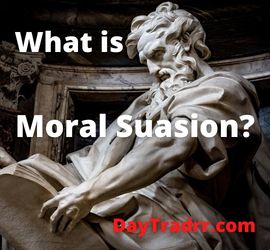What Is Moral Suasion?
 Moral suasion is the act of using verbal arguments, appeals, and persuasion to influence a person or group of people to change their behavior. This is in contrast to using overt coercion or physical force. In other words, moral suasion uses diplomatic verbal strategies rather than force or coercion to persuade individuals to behave in a specific way. In economics, moral suasion is more clearly described as an endeavor to influence private economic actions. However, this is accomplished by governmental encouragement rather than through previously specified or current statutory legislation. As a result, it is sometimes used to refer to how central banks function.
Moral suasion is the act of using verbal arguments, appeals, and persuasion to influence a person or group of people to change their behavior. This is in contrast to using overt coercion or physical force. In other words, moral suasion uses diplomatic verbal strategies rather than force or coercion to persuade individuals to behave in a specific way. In economics, moral suasion is more clearly described as an endeavor to influence private economic actions. However, this is accomplished by governmental encouragement rather than through previously specified or current statutory legislation. As a result, it is sometimes used to refer to how central banks function.
Moral suasion may be used by anybody to attempt to persuade another party to alter their attitude or conduct. However, in an economic context, it often refers to central bankers’ employment of persuasive methods in public or private. In this regard, it is sometimes referred to as simply suasion. This is because the motivations behind it are not necessarily altruistic or moral. Rather, they have to do with the pursuit of certain agendas. In U.S. politics, moral suasion is also known as jawboning, since it amounts to nothing more than rhetoric and talk. This is in contrast to the more forceful methods the Federal Reserve and other policymakers have at their disposal. For example, influencing the rate of inflation in an open market without specific legislative procedures.
Moral Suasion vs Suasion
A central bank may utilize moral suasion measures in public or private. However, the aim behind the use may not always be selfless in character. This is why the word employed in the business arena is often simply suasion. Although policymakers have access to a variety of instruments, the tools are not always effective. For example, when a central bank is unable to make a policy measure public or chooses to take subtle action. In those cases, it may turn to persuasion. Suasion then becomes a conversation between the central bank and commercial banks. In particular, it implies that the central bank offers information and other services. In exchange, it encourages cooperation among commercial banks in return for their conformity with the central bank’s aims.
Moral Suasion & Fedspeak
Moral suasion may be used both publicly and privately. Fed chair Alan Greenspan’s 1996 criticism of the prevailing economic mood as “irrational exuberance” is a classic example. Greenspan chose to use suasion instead of some other direct intervention. However, when asset prices did collapse in 2000, critics attacked Greenspan for doing too little. He could have raised interest rates or margin lending requirements to directly check the exuberance of the 1990s.
The Fed has made a determined effort in recent years to communicate more with the public. This may be seen as an attempt to promote transparency—or to harness its power of moral suasion. Greenspan pushed for a strategy of constructive ambiguity which is arguably the inverse of moral suasion. The Fed Chair memorably told a senator, “if you comprehended what I said, I must have misspoken.” Ben Bernanke deviated from this strategy and made an attempt to convey Fed policy more clearly. This was at the recommendation of his eventual successor, Janet Yellen. At Yellen’s suggestion, Bernanke instituted news conferences in 2011.
Moral persuasion is not restricted to the United States. In 2012, European Central Bank (ECB) President Mario Draghi said that the bank will do “whatever it takes” to save the euro. These remarks bolstered the battered currency and helped its subsequent recovery.
When is Moral Suasion Used?
Low-interest rates are typically a characteristic of an expansionary monetary policy phase. A low-interest-rate environment may promote economic development, but it has a disadvantage. The central bank has little to no leeway in enacting policy measures to achieve its inflation targets. In a near-zero-interest-rate environment, the central bank has no options available to slash rates further. This is the environment that existed from December 2008 to December 2015. The size of the government’s balance sheet grows as a result of expansionary policies. Therefore, acquiring additional government debt becomes increasingly difficult.
From December 2008 through December 2015, the Fed recognized its diminished capacity to cut interest rates or expand its balance sheet. Increased jawboning and closed-door arm twisting were the only tools left. Conventional monetary policy instruments were increasingly difficult to utilize. Therefore, the Fed sought to persuade markets of its determination to support a durable economic recovery. However, they used words and suasion rather than direct actions.
Even if the central bank has minimal control over the market in terms of monetary policy instruments, it must still persuade the market otherwise. If the market believes a central bank is not in control of the economy, it may lead to a dollar run and a financial catastrophe. Using moral suasion tactics, a central bank persuades the public of its intent – and capacity – to promote future economic recovery. The minutes of a central bank’s monetary policy review meeting, for example, can be worded in such a manner as to indicate such a reality. Journalists and analysts then dissect it and relay the sentiments to the market.
Moral Suasion Example
Long-Term Capital Management (LTCM) was a highly successful, yet highly leveraged hedge fund. The Asian Financial Crisis struck LTCM hard in 1998. The bulk of LTCM’s lenders were Wall Street’s big banks. If LTCM failed, creditors might face an even larger number of non-performing assets on their books.
The Federal Reserve found itself in a difficult situation and was unable to directly finance a bailout. Particularly since utilizing government cash for the rescue would enrage the broader public. As a result, the Fed was forced to coordinate an alternate rescue plan for the corporation. They were successful in creating the appearance that the corporation was too large to fail. In the end, the company was bailed out for $3.6 billion by 14 cooperating banks. Two years later, the fund was liquidated. The Federal Reserve was chastised for its coordination of the rescue. However, this was preferable to taking direct action using government funds and taxpayers’ money.
Up Next: What is Price to Free Cash Flow?
 Price to free cash flow is an equity valuation tool that compares a company’s market price per share to its free cash flow per share (FCF). This metric is very similar to the price to cash flow valuation metric, but it is considered a more precise measure. This is because it uses free cash flow, which subtracts capital expenditures (CAPEX) from a company’s total operating cash flow. As a result, it reflects the actual cash flow available to fund non-asset-related growth. Companies utilize this statistic either to develop their businesses or to maintain acceptable levels of free cash flow.
Price to free cash flow is an equity valuation tool that compares a company’s market price per share to its free cash flow per share (FCF). This metric is very similar to the price to cash flow valuation metric, but it is considered a more precise measure. This is because it uses free cash flow, which subtracts capital expenditures (CAPEX) from a company’s total operating cash flow. As a result, it reflects the actual cash flow available to fund non-asset-related growth. Companies utilize this statistic either to develop their businesses or to maintain acceptable levels of free cash flow.
What is Free Cash Flow?
Free cash flow (FCF) is the cash that remains after a company pays for its operations and makes any capital expenditures. Capital expenditures are purchases of physical assets such as property and equipment. Net income is linked to, but not the same as, free cash flow. Net income is typically used to assess a company’s profitability. However, free cash flow gives a deeper understanding of a company’s business strategy and financial health. Value investors use this ratio to assess a company’s financial position in relation to its current stock price. It is a more stringent metric than the price to cash flow ratio since it deducts capital expenditures from cash flow.




